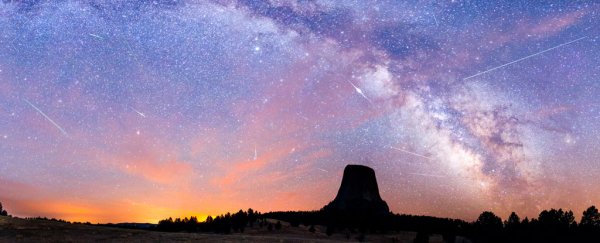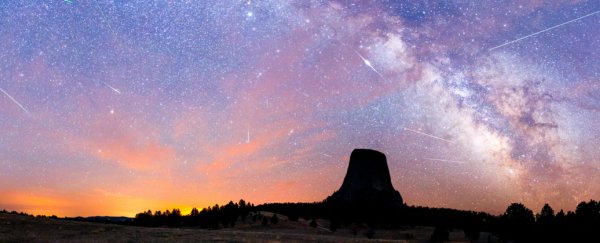We are in the midst of a meteor shower. Right now, Earth is twirling through the tail of Halley's Comet, arguably the most famous comet in our Solar System.
And as tiny grain-of-rice-size bits of debris smack into our atmosphere and burn up, they sizzle through the sky in a month-long annual spectacle known as the Eta Aquarids. They run from April 20 until May 21 this year and will reach their peak on the evening of Thursday, May 5.
Lucky stargazers in the Southern Hemisphere will see meteors dash through the sky at a rate of about 30 or 40 per hour. But Northern stargazers won't be left completely in the dust – they'll still be able to see about 10 to 20 meteors per hour.
How to watch
Prime time for the Eta Aquarids will be during the shower's peak, May 5 through May 7. The new moon on May 6 will offer the darkest skies, providing a perfect backdrop for the shooting stars.
Plan on camping out one or two hours before twilight, as our planet turns into the meteor stream.
You won't need any telescopes or fancy equipment to see the meteors, just clear skies, your eyes, and a little bit of patience. Find a dark, remote spot away from the light pollution of nearby towns and cities, make yourself comfortable, and set aside a good chunk of time to enjoy the show.
"Give yourself at least an hour of viewing time for watching any meteor shower," EarthSky.org advises. "Meteors tend to come in spurts that are interspersed by lulls. Also, it can take as long as 20 minutes for your eyes to adapt to the dark."
If bad weather or bright lights are preventing you from catching any meteors, Slooh, an online observatory, will be offering a live broadcast of the meteor shower from an observatory on the Canary Islands. See the broadcast stream below.
During the broadcast, professional astronomers will discuss the meteor shower and take questions from the public.
Although Halley's Comet, a ball of ice and rock left over from the formation of our Solar System, only makes an appearance every 75 years - we haven't seen it since 1986 - Earth passes through its tail twice a year. We'll pass through Halley's tail again in late October, resulting in the Orionid meteor shower.
 Halley's Comet last crossed the Milky Way in 1986. Credit: NASA
Halley's Comet last crossed the Milky Way in 1986. Credit: NASA
What causes a meteor shower?
The orbits of comets are often a little lopsided. When a comet swings too close to the sun, the Sun's light boils its icy surface, releasing particles of ice and dust.
This debris follows the comet's path, forming a tail that points away from the Sun. As Earth crosses the orbit of this comet, we pass through the tail.
The gravity of our planet attracts the dust and ice Halley has left in its wake. When the debris is pulled into our atmosphere, it rubs up against air molecules, causing the debris to burn up and streak through the sky.
This results in glowing trails of light that we see as meteors, or 'shooting stars'.
During the Eta Aquarids, Earth will collide head on with the debris and meteors will travel through our atmosphere at a speed of about 40 miles per second (64 kilometres per second).
They can appear anywhere in the sky, but if you trace their paths back, they all appear to come from the same point: the radiant. That's because the meteors are all approaching us at the same angle. Meteor showers are all named after the radiant that the meteors can be traced back to.
This particular shower's radiant, the faint star Eta Aquarii, is 168 light-years away in the constellation Aquarius. It is south of the celestial equator, which is why observers in the Southern Hemisphere get a better show.
Check out the livestream from Slooh on Thursday, May 5, at 8pm EST below:
This article was originally published by Business Insider.
More from Business Insider:


